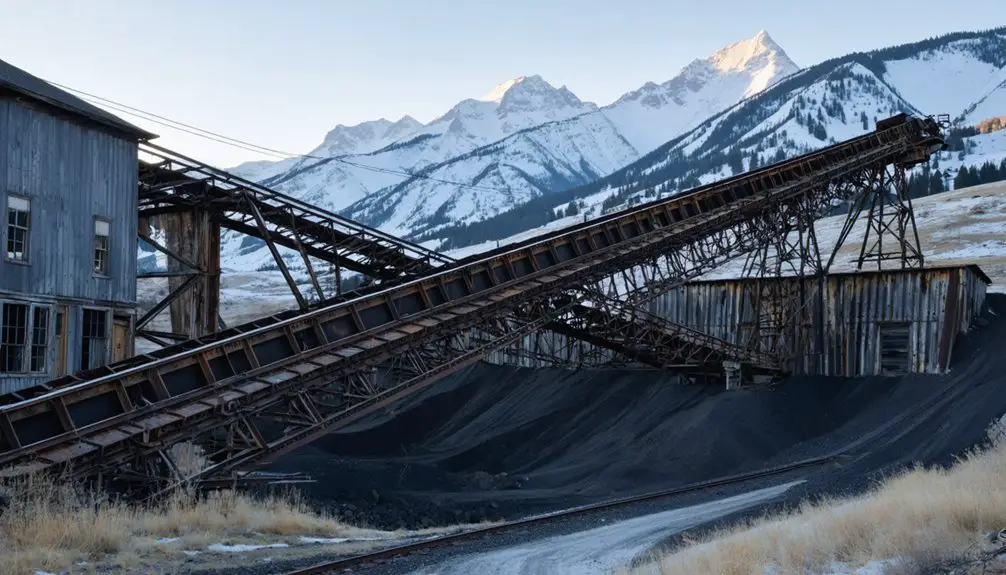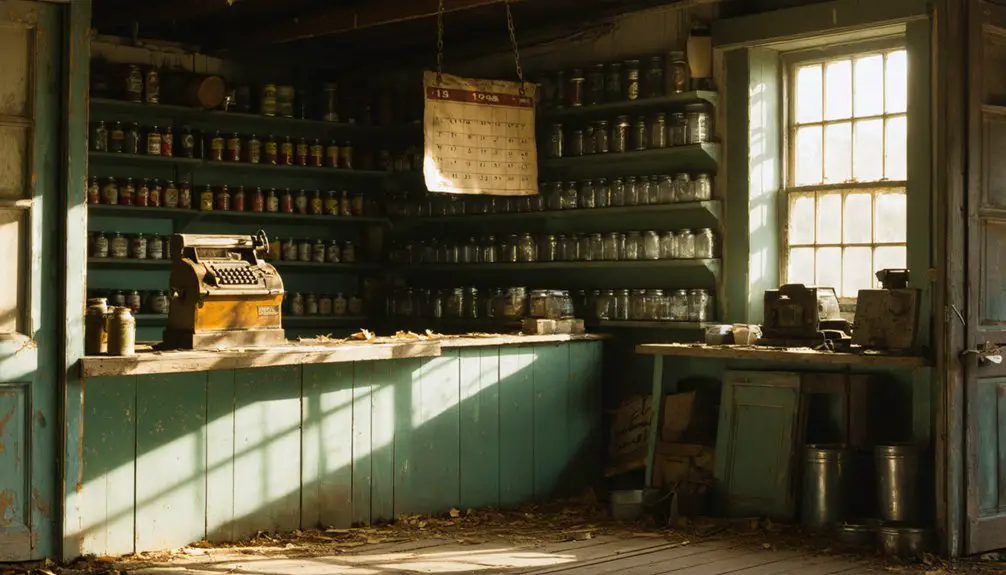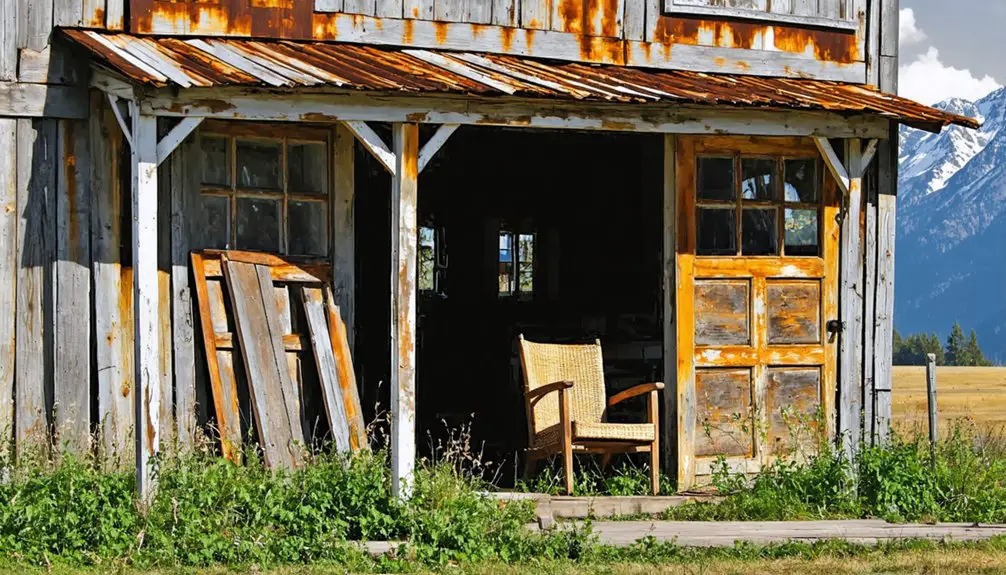You’ll find the historic ghost town of Jardine tucked away in Montana’s Garnet Mountains, where gold was discovered in 1865 by Bob and Joe Booth and Charles Hickey. The town flourished between 1898 and 1948, growing to 600 residents with modern amenities like hydroelectric power and telephone service. Today, you can explore weathered miners’ cabins, remnants of the 1903 dam, and foundations of the 20-stamp mill. This mountain settlement holds countless stories of boom, innovation, and decline.
Key Takeaways
- Jardine was a thriving gold mining town established in 1898, reaching its peak with 600 residents during Montana’s mining boom.
- The town featured modern amenities including hotels, stores, water systems, telephone service, and a hydroelectric dam by 1903.
- Mining operations ended in 1948 when fire destroyed the cyanide plant, leading to Jardine’s transformation into a ghost town.
- Visitors can explore original structures, miners’ cabins, and industrial remnants like the 20-stamp mill and hydroelectric dam foundations.
- Located six miles from Gardiner, Montana, Jardine is accessible via dirt road and showcases authentic mining camp history.
The Discovery of Gold at Bear Gulch
When Bob and Joe Booth and Charles Hickey discovered gold at Bear Gulch in late fall 1865, they couldn’t have known their find would spark a mining boom worth millions.
You’ll find that early gold discovery efforts focused on rich deposits hidden beneath massive boulders, which prospectors moved using crude wooden rollers crafted from pine logs.
The following year, Joe Brown and his partners struck it rich at the gulch’s mouth, pulling out $8,000 in gold.
Mining techniques evolved as prospectors explored both surface gravel bars and ancient channels through tunnels and hillside drifts.
Later operations expanded when Major George O. Eaton introduced hydraulic mining operations in 1884.
Initial prospecting was halted due to heavy winter snow until spring 1866.
A Town Rises From the Montana Wilderness
After Harry Bush arrived in 1898, the remote Bear Gulch area transformed into a bustling mining settlement known as Jardine.
Like many gold rush boomtowns, Jardine emerged from the Montana wilderness as a symbol of human determination and survival instinct. Bush’s vision for the town included expanding the mill’s capacity and carefully planning the settlement’s layout. Unfortunately, despite initial success, the operation ultimately failed due to poor money management. Similar to other mining settlements like Garnet, the town boasted an impressive thirteen saloons during its peak.
Jardine rose from untamed Montana land, driven by the pioneering spirit and Bush’s calculated vision for a thriving gold town.
- Within just one year, you’d have witnessed 130 new buildings spring up, including hotels and mercantile stores.
- Modern amenities arrived swiftly – water systems, telephone service, and by 1903, a hydroelectric dam on Bear Creek.
- The population swelled to 600 residents as wilderness gave way to civilization.
Life in Early Jardine’s Booming Days
During Jardine’s peak years around 1907, you’d find the streets bustling with miners heading to work, children walking to school, and residents shopping at one of three mercantile stores that supplied everything from mining equipment to household goods.
You could grab a room at either of the town’s hotels or the guest house, which served as social gathering spots where miners and townspeople would share news and stories after long workdays.
The town’s growth brought essential services like telephone lines and electricity from the Bear Creek hydroelectric dam, making Jardine one of Montana’s most modern mining communities of its era. The introduction of new cyanide plant technology in 1903 helped modernize the mining operations even further. Like many old West settlements, the town’s history became interwoven with tales of outlaws and hidden treasures.
Daily Activities and Entertainment
At its peak, life in Jardine bustled with social activities that brought together its 500-600 residents in meaningful ways. Community events centered around the town’s two hotels and guest house, where you’d find miners and their families gathering for dances, parties, and storytelling sessions. Like the town’s fourteen saloons in Garnet, these gathering spots were essential to the community’s social fabric.
Your recreational activities would have included:
- Card games and gambling in the town’s vibrant saloons
- Outdoor adventures like fishing and hiking in the nearby Yellowstone wilderness
- Social gatherings powered by the town’s modern amenities, including electric lights and telephone service
The mercantile establishments served as social hubs where you could exchange news and stories while shopping for supplies.
The school brought families together, creating a strong sense of community that set Jardine apart from typical mining camps.
Commerce and Trading Posts
The economic heartbeat of early Jardine flowed through its bustling trading posts, which served as essential commercial hubs where miners, settlers, and Native Americans exchanged goods and conducted business.
You’d find these posts strategically placed near rivers and trails, some fortified to protect valuable merchandise and their traders. Many trading posts included dry goods stores with attached living quarters for the owners.
As Jardine’s mining boom intensified, trading dynamics shifted from fur and pelt exchanges to mining-focused commerce.
The competition between Bear Gulch and Revenue mining companies in 1899 reshaped local business relationships. Local establishments often resembled the twenty-eight saloons that dominated early Gardiner’s landscape.
You could witness the mercantile evolution as simple trading posts transformed into full-service stores, stocking everything from mining equipment to household essentials.
The arrival of the Northern Pacific Railroad through nearby Gardiner expanded commercial opportunities, though Jardine remained primarily focused on its mining identity until its eventual decline.
Community Buildings Take Shape
Rapid growth swept through Jardine in 1898-1899, transforming the mining settlement into a proper town with about 130 buildings rising from the Montana landscape within just one year.
Community planning efforts focused on establishing essential social infrastructure, ensuring you’d find everything needed for a thriving frontier life. Much like the historic W.A. Hall Store that opened in 1903, these establishments aimed to provide vital supplies and services to the area’s residents.
Key community buildings that shaped Jardine’s identity included:
- Two hotels and guest houses to welcome newcomers and travelers
- A schoolhouse serving the growing number of mining families
- Multiple office buildings and mercantile establishments
Mining Operations and Technological Advances

While early mining efforts in Jardine focused on traditional gold extraction, significant technological advances transformed the district’s operations between 1918 and 1948.
You’ll find the evolution of mining technologies reflected in the construction of a 150-ton cyanide plant and a specialized $125,000 arsenic facility. The introduction of hydroelectric power revolutionized ore processing capabilities, enabling more efficient handling of complex minerals including gold, tungsten, and arsenopyrite.
The Jardine Mining Company’s consolidation in 1921 brought modern innovations to the district, though success remained elusive due to financial mismanagement.
Despite advanced milling infrastructure and diverse ore processing methods, operations faced recurring challenges. The district’s technological journey ended abruptly in 1948 when fire destroyed the cyanide plant, marking the conclusion of Jardine’s major mining era.
The Rise and Fall of Corporate Mining Ventures
Corporate mining ventures in Jardine began taking shape in the late 1890s, as entrepreneurs like Harry Bush transformed the district’s scattered claims into organized operations.
While early corporate strategies focused on infrastructure development and technological advancement, persistent financial mismanagement led to instability.
- A $125,000 arsenic extraction plant built in 1923 showcased ambitious industrial expansion
- Multiple ownership changes plagued operations until the Jardine Mining Company took control in 1917
- Market pressures and fluctuating commodity prices forced constant operational adjustments
You’ll find that despite substantial investments in mills, hydroelectric plants, and processing facilities, these corporate ventures struggled to maintain profitability.
Recurring challenges included poor mine development, legal disputes, and unstable revenue streams from gold and arsenic production.
Daily Life and Community Development

As Jardine’s population swelled during the 1898 mining boom, a distinct community emerged alongside its industrial growth.
You’d find remarkable community resilience as families made permanent homes here, setting Jardine apart from typical transient mining camps. The social dynamics created a unique blend, with some residents choosing to work in nearby Gardiner while living in Jardine’s quieter setting.
Life centered around the mining operations, where you’d see everything from simple miners’ cabins to company housing dotting the landscape. A modern hydro-electric plant powered both the mines and town facilities, though many buildings were hastily constructed.
Despite the challenges of geographic isolation and financial instability, residents maintained a year-round community life, gathering for informal social activities and creating their own small-town atmosphere.
Industrial Legacy and Innovation
Since its inception in the late 1800s, Jardine’s mining operations showcased remarkable technological innovation and industrial complexity. The district’s industrial heritage reflects a pioneering spirit, from early arrastras to sophisticated underground mining networks.
You’ll find evidence of technological evolution throughout the site’s history:
- A groundbreaking hydroelectric dam on Bear Creek powered the entire operation from 1903, demonstrating early adoption of renewable energy
- Complex extraction methods targeting multiple metals, including gold, tungsten, arsenic, and copper through over 30 adits and 4 main cuts
- Advanced processing facilities, including a specialized arsenic mill built in 1923 for pesticide production
This rich industrial legacy transformed Jardine from a simple mining camp into a thriving industrial center with extensive infrastructure, including water systems, telephone service, and extensive corporate operations.
The Path to Becoming a Ghost Town

While initial prosperity drew hopeful miners to Jardine’s gold-rich creeks in the 1800s, the town’s decline emerged through a perfect storm of challenges.
You’ll find that the economic challenges began when easily accessible placer gold became depleted, forcing miners to seek deeper veins that proved harder to extract.
The town’s remote location in the rugged Garnet Mountains didn’t help, as you’d have struggled to transport heavy mining equipment over poorly developed roads.
The mining decline accelerated after the 1893 Sherman Silver Purchase Act repeal, which destabilized the regional mining economy.
When the cyanide processing technology finally arrived in 1892, it was too late to save Jardine.
As mining profits dwindled, the population scattered, leaving behind their schools, saloons, and dreams of striking it rich.
Exploring Historic Jardine Today
Today, when you visit historic Jardine, you’ll discover a unique blend of past and present nestled in Montana’s rugged Garnet Mountains. This remarkable site of ghost town tourism offers a rare glimpse into Montana’s mining heritage, with numerous original structures still standing alongside active residences.
- Explore weathered miners’ cabins and the remnants of the 1903 hydroelectric dam while following old mining roads.
- Photograph industrial artifacts, including foundations of the 20-stamp mill and cyanide plant.
- Witness historical preservation in action as modern residents maintain their homes amid the historic landscape.
You’ll find Jardine easily accessible via a six-mile dirt road from Gardiner. While the main mine site remains fenced off, you can still experience the authentic mining camp atmosphere and stunning mountain views that make this ghost town uniquely enchanting.
Frequently Asked Questions
What Were the Average Wages for Miners in Jardine During Peak Operations?
You’ll find historical records don’t specify exact mining wages, but Montana miners typically earned $3-5 daily during Jardine’s peak operations, with additional compensation through overtime and piecework arrangements.
Were There Any Major Accidents or Disasters Besides the 1948 Mill Fire?
While accident reports were typical for mining towns, historical records don’t show other major disasters besides the 1948 fire. You’ll find minimal disaster stories despite common mining hazards of the era.
How Did Winters Impact Mining Operations and Daily Life in Jardine?
You’d face severe winter hardships with blocked roads, frozen equipment, and seasonal shutdowns. Mining adaptations included building storage facilities and winterizing machinery, while residents relied heavily on stored provisions.
What Happened to the Original Mining Equipment After Operations Ceased?
While you might expect valuable mining equipment was sold off, it was actually abandoned after the 1948 fire. You’ll find these historical remnants deteriorating in place, serving as preserved artifacts of early mining technology.
Did Any Famous or Notorious Outlaws Ever Visit Jardine?
You won’t find any confirmed outlaw encounters or notorious visits in Jardine’s history. While surrounding Montana mining towns saw their share of outlaws, there’s no evidence famous criminals ever reached this location.
References
- https://www.mtghosttowns.com/jardine
- https://www.legendsofamerica.com/jardine-montana/
- https://www.geyserbob.com/jardine
- https://www.roadunraveled.com/blog/garnet-ghost-town-montana/
- http://kotybear.blogspot.com/2010/10/jardine-montana-ghost-town.html
- https://oldmissoula.com/beartown-history-by-mary-j-pardee/
- https://mhs.mt.gov/education/textbook/chapter6/Chapter6.pdf
- https://www.blm.gov/sites/default/files/docs/2021-07/THE ROAD TO GARNET’S GOLD (002).pdf
- https://www.foxbusiness.com/video/shows/american-gold-the-legend-of-bear-gulch
- https://www.garnetghosttown.org/history.php



